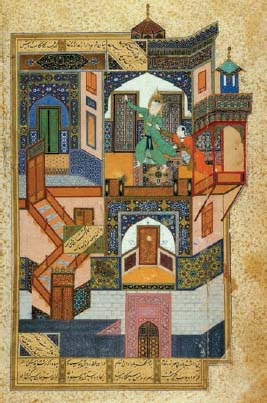The Early Modern World, C. 1300–1600Islamic Art and the Ottoman Empire |
Who was Bihzad? |
Kamal al-Din Bihzad, referred to simply as Bihzad, was one of the most famous Persian manuscript painters during the fifteenth century. He was born around 1450 in the city of Herat, in modern-day Afghanistan. He worked for royal courts under both Timurid and Safavid rule. (The Timurid rulers descended from Genghis Khan, and were succeeded by the Safavids as rulers of Iran.) Bihzad’s paintings are characterized by vivid color, dynamic detail, and warping perspective. His work notably includes representations of figures, something more common in Persian and Indian painting than other Islamic art.
One of Bihzad’s most famous miniature paintings is Seduction of Yusuf (c. 1488), a story included in both the Bible and the Qur’an. In the story, Yusuf (Joseph) is seduced by Zulaykha, the wife of Potiphar. According to the Persian version of the tale, Zulaykha led Yusuf through seven rooms of her palace, locking the door of each room behind her. In the final room, she propositioned Yusuf, but he was able to escape when the doors were miraculously unlocked. In the painting, zigzagging beige panels contain the actual Arabic text of the story at the top, bottom, and in the middle of the manuscript page. Zulaykha’s palace is made up of intricately decorated, multicolored panels connected by angled, polygonal staircases. This geometric, two-dimensional painting gives the illusion of three-dimensional space and is a masterpiece of Persian manuscript painting.

Islamic art maintains a long tradition of miniature painting. This highly detailed illustration, Seduction of Yusuf, was painted by the fifteenth-century Persian master Bihzad.
